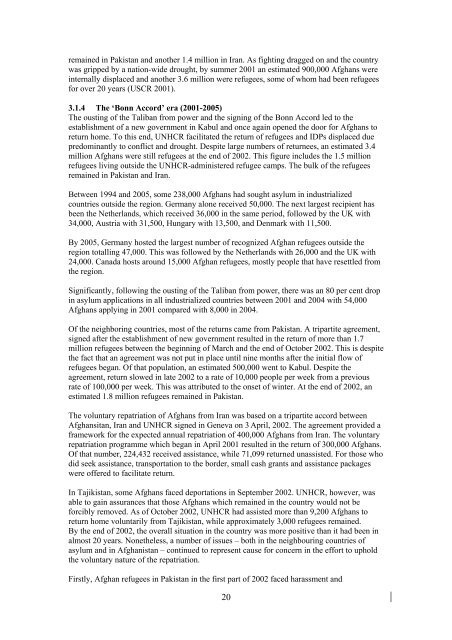Afghanistan. - Forced Migration Online
Afghanistan. - Forced Migration Online
Afghanistan. - Forced Migration Online
Create successful ePaper yourself
Turn your PDF publications into a flip-book with our unique Google optimized e-Paper software.
emained in Pakistan and another 1.4 million in Iran. As fighting dragged on and the country<br />
was gripped by a nation-wide drought, by summer 2001 an estimated 900,000 Afghans were<br />
internally displaced and another 3.6 million were refugees, some of whom had been refugees<br />
for over 20 years (USCR 2001).<br />
3.1.4 The ‘Bonn Accord’ era (2001-2005)<br />
The ousting of the Taliban from power and the signing of the Bonn Accord led to the<br />
establishment of a new government in Kabul and once again opened the door for Afghans to<br />
return home. To this end, UNHCR facilitated the return of refugees and IDPs displaced due<br />
predominantly to conflict and drought. Despite large numbers of returnees, an estimated 3.4<br />
million Afghans were still refugees at the end of 2002. This figure includes the 1.5 million<br />
refugees living outside the UNHCR-administered refugee camps. The bulk of the refugees<br />
remained in Pakistan and Iran.<br />
Between 1994 and 2005, some 238,000 Afghans had sought asylum in industrialized<br />
countries outside the region. Germany alone received 50,000. The next largest recipient has<br />
been the Netherlands, which received 36,000 in the same period, followed by the UK with<br />
34,000, Austria with 31,500, Hungary with 13,500, and Denmark with 11,500.<br />
By 2005, Germany hosted the largest number of recognized Afghan refugees outside the<br />
region totalling 47,000. This was followed by the Netherlands with 26,000 and the UK with<br />
24,000. Canada hosts around 15,000 Afghan refugees, mostly people that have resettled from<br />
the region.<br />
Significantly, following the ousting of the Taliban from power, there was an 80 per cent drop<br />
in asylum applications in all industrialized countries between 2001 and 2004 with 54,000<br />
Afghans applying in 2001 compared with 8,000 in 2004.<br />
Of the neighboring countries, most of the returns came from Pakistan. A tripartite agreement,<br />
signed after the establishment of new government resulted in the return of more than 1.7<br />
million refugees between the beginning of March and the end of October 2002. This is despite<br />
the fact that an agreement was not put in place until nine months after the initial flow of<br />
refugees began. Of that population, an estimated 500,000 went to Kabul. Despite the<br />
agreement, return slowed in late 2002 to a rate of 10,000 people per week from a previous<br />
rate of 100,000 per week. This was attributed to the onset of winter. At the end of 2002, an<br />
estimated 1.8 million refugees remained in Pakistan.<br />
The voluntary repatriation of Afghans from Iran was based on a tripartite accord between<br />
Afghansitan, Iran and UNHCR signed in Geneva on 3 April, 2002. The agreement provided a<br />
framework for the expected annual repatriation of 400,000 Afghans from Iran. The voluntary<br />
repatriation programme which began in April 2001 resulted in the return of 300,000 Afghans.<br />
Of that number, 224,432 received assistance, while 71,099 returned unassisted. For those who<br />
did seek assistance, transportation to the border, small cash grants and assistance packages<br />
were offered to facilitate return.<br />
In Tajikistan, some Afghans faced deportations in September 2002. UNHCR, however, was<br />
able to gain assurances that those Afghans which remained in the country would not be<br />
forcibly removed. As of October 2002, UNHCR had assisted more than 9,200 Afghans to<br />
return home voluntarily from Tajikistan, while approximately 3,000 refugees remained.<br />
By the end of 2002, the overall situation in the country was more positive than it had been in<br />
almost 20 years. Nonetheless, a number of issues – both in the neighbouring countries of<br />
asylum and in <strong>Afghanistan</strong> – continued to represent cause for concern in the effort to uphold<br />
the voluntary nature of the repatriation.<br />
Firstly, Afghan refugees in Pakistan in the first part of 2002 faced harassment and<br />
20
















